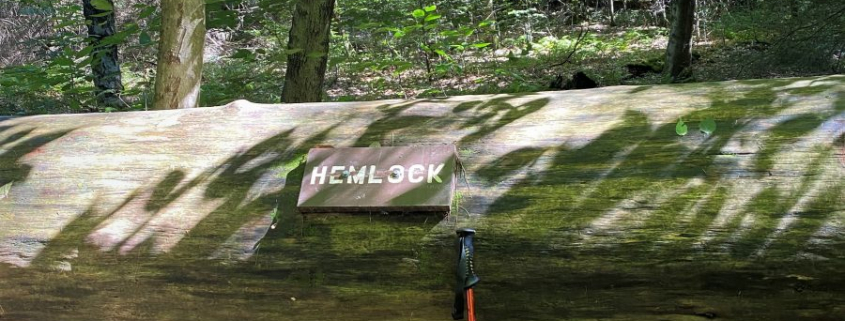Heart’s Content in NW Pennsylvania (Part Two)
The Special Nature of an Old Growth Allegheny Hardwood Forest
September 7, 2021 I hiked and explored the Heart’s Content Scenic Area (a 400-year-old remnant of the original forest that covered the Allegheny Plateau when European settlers arrived in the 18th Century) in the Allegheny National Forest of northwest Pennsylvania. This preserved area is located just 40 miles west of where I conducted my 1985-86 doctoral research on soil-site relationships for second-growth Allegheny hardwoods. This was my first return to the Allegheny in 35 years!
I issued a first Post from this visit October 14, 2021, focusing on the origin chronology of the 90-100-year-old second growth forests of my doctoral research, and the species composition within this ancient forest: https://stevejonesgbh.com/wp-admin/post.php?post=9643&action=edit
This Post focuses on the special Nature of this ancient forest.
We have all read some of the earliest European settlers’ accounts of the deep forests greeting them when they arrived on our North American shores: forests dark and foreboding, foul and repugnant; teeming wtih wild beasts and savages. Perhaps some 17th century New England forests were dark and foreboding. Such is not the case today at Heart’s Content. The stand beyond the entrance sign below looks rather dark, yet, dappled sulight is penetrating the forest. The trail (below right) wends through patches of sunlight and deep shade.
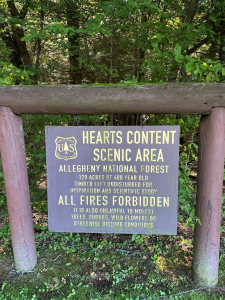
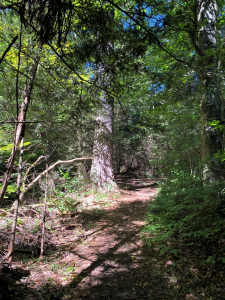
Sunlight brightens the trunks of a massive hemlock (left) and red oak, both 3-4 feet in diameter.
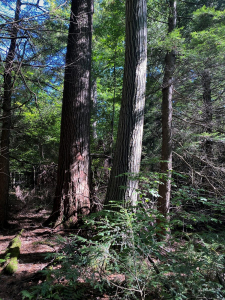
Large dead and down woody debris characterizes the forest floor. The hemlock log below left measures four feet at what would have been breast-high when the tree stood. Sunlight is spotlighting the log and dappling the diverse woody debris below right. Old growth characteristics in our eastern forests include some large individuals, a great deal of dead and down woody debris, scattered crown openings, ansd multi-tiered crown structure. The two photos evidence all elements.
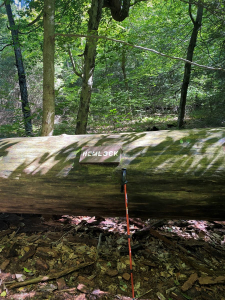
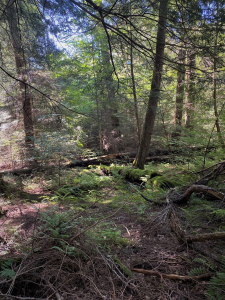
The ancient main canopy individuals, across all species, reach straight and tall (see the hemlock and oak photos above) to their first branches, suggesting that for at least the stand’s first century-plus, full stocking provided sunlight only to the active high crowns. The white pine (left below) is typical of the ancient Heart’s Content individuals. The white pine below right stands near the parking area, likely planted nearly a century ago when officials dedicated the preserve. The differences in appearance are distinct, reflecting available sunshine during that first century following establishment. The old growth tree competed fiercely for sunlight above its elongating primary shoots, hemmed in on all sides by adjacent trees, the tip to some extent shaded. The planted white pine below right presents a form referred to as a cabbage pine. White pine weevils ruthlessly lay eggs in the terminal and lateral shoots that recieve full sunlight. Year after year, weevils infested the primary shoots of this pine, restricting the expression of single stem apical dominance. Each successive year resulted in compound forking, leading to its squat cabbage-like form. Dense lateral competition for most species “trains” the winners (those that out-compete their neighbors) to grow straight and true, striving vertically for the full sunlight above. The cabbage pine has no commercial timber value, yet, it contributes unlimited benefits: aesthetic, wildlife cover, and seed production for critter-consumption. I viewed it as a curioisity and a tool for learning and interpretation.
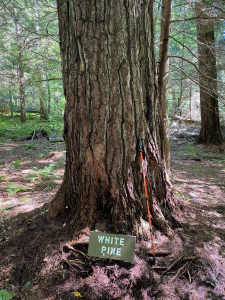
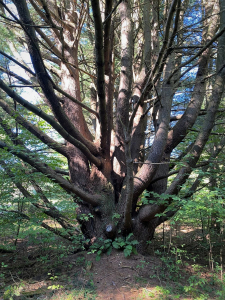
Nothing lives without end. The dance of life and death is continuous. Yes, the forest can live on and on, yet, individual trees die even as the forest persists. The massive hemlocks below fell from the canopy decades ago, slowly yielding their biomass to decay organisms, inexorably reincorporating into the forest floor, and from there recycling to living and emerging shrubs and trees.
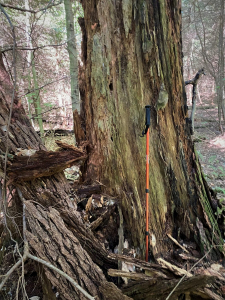
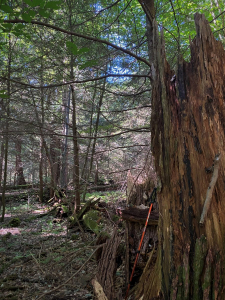
Mosses are abundant, carpenting and enshrouding downed debris. Fungi mycelium account for large quantities of biomass within the decaying woody debris. A few orange mushrooms dot the mossy log below right. Life and death embrace in the great circle of forest ecosystems, a reality more easily grasped in such ancient forests.
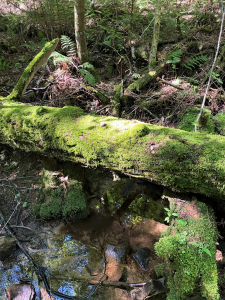
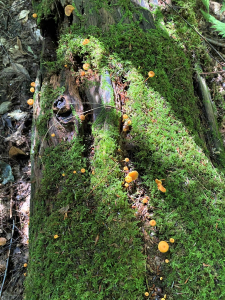
The 3-4-foot diameter hemlock and white pine below left (white pine in foreground) stood shoulder to shoulder across four centuries. The pine is recently dead, its bark still clinging. The pine has already begun its return to the soil. Its crown is needle-free. Fungi, I am certain, have already found entrance to the wood through unseen fissues in the dead bark. Within a few years, the bark will slough, mushrooms with decorate the trunk, the small branches will break and fall. In time, gravity will prevail and the tree will find the forest floor.
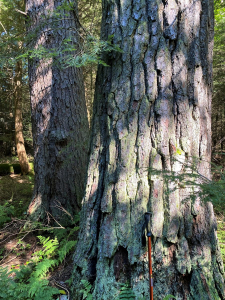
The introduced emerald ash borer entered our eastern forests from Asia, first detected in Michigan in 2002, and now reported in 35 states, including Alabama. The pests’ mortality front is racing southward across Tennessee heading our way. The photo below right shows the canopy void from an original growth white ash. The borer does not show deference to the elderly. During my two days exploring forests in northwest and west-central Pennsylvania, I found no living ash.
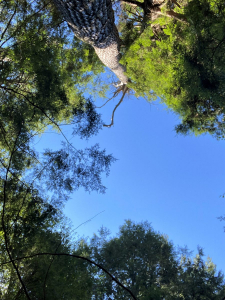
How tragic that our white and green ash will go the way of American chestnut (chestnut blight) and our emblematic elm (Dutch elm disease).
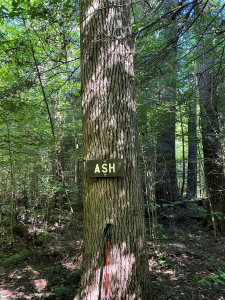
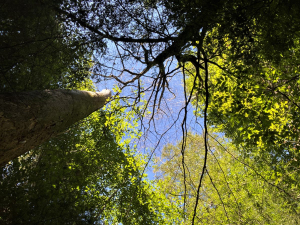
Forest Curiosities
Not all disease organisms lead to imminent death. The American beech below has a circumferential canker, likely caused by viral, fungal, or bacterial action introduced by a physical injury. From forestpathology.org:
A canker is an infectious disease of the phloem and cambium on stems, branches or twigs of trees. A patch of phloem and cambium is killed, the underlying wood dies as a result, and the killing often progresses over time. Cankers are often sunken if they grow slowly because the shoot continues to grow around it. Also, callus may be produced around the canker that makes it appear more sunken.
There are some diseases usually considered with other groups that are cankers, as well as injuries that can be confused with cankers:
- Bacterial cankers. These are covered with bacterial diseases.
- Canker rots. Some basidiomycetes that decay wood in the stem may also kill patches of sapwood and bark. We consider most of them along with stem-decay fungi.
- Stem rusts. These cause cankers, but we consider them separately with the rusts.
- Foliage diseases, shoot and tip blights. Some of these kinds of diseases also can involve small cankers of twigs, branches, and even main stems; they are considered under foliage diseases.
- Winter injury or sunscald. These kill patches of bark, and can be confused with cankers. Also, canker pathogens can infect living tissues at the margins, so they can become cankers.
I am fascinated, as I have professed often in these Posts, with tree form oddities and curiosities, like the American beech below.
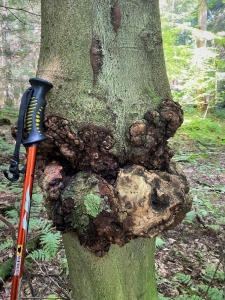
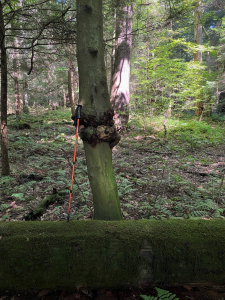
If the white pine and hemlock earlier were standing shoulder to shoulder across the four centuries, the white pine and American beech below are in centuries-long warm ebrace. Yet another forest curiosity. Now for a not-so-warm commentary on the stupidity and ignorance of the human psyche. Why do we insignifcant, supposedly intelligent humans, behave as idiot pissants when confronted by a smooth-barked beech? Why, with pocketknife in-hand, do some ignorant oafs insist upon leaving the mark of their fleeting existence upon a tree in a 400-year-old forest cathedral? Why not strive to leave some small corner of the world better through wisdom, knowledge, passion, and hard work! As I frequently remind my grandkids, “You can’t fix stupid!”
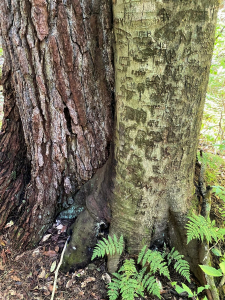
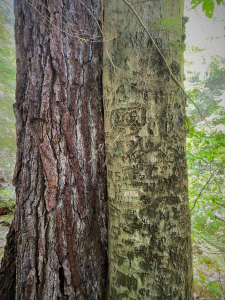
The eastern newt seemed quite content here in Heart’s Content, living and thriving among the decay, dampness, and nutrient-rich oasis of 400 years worth of bountiful life and its associated dead and down woody debris. How considerate (no arrogance and studpidity in this amphibian species) of the eastern newt to announce his neon-presence so splendidly!
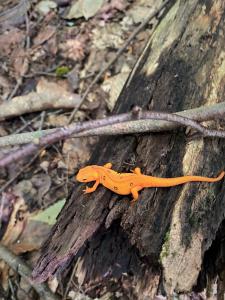
I express my gratitude for those who preserved and donated the original 20 acres of old growth for preservation across time, so that we may believe, look, see, feel, and act in response. May we continue to be worthy and deserving recipients of the gift and foresight…and pass such benevolence on to future generations.
Thoughts and Reflections
I offer these observations:
- We prepare most readily for the future when we understand the past.
- So readily apparent in old growth, all forests engage in a continuous cycle of life and death.
- Just as others before us preserved special places in Nature, we all must do our part to lay the foundation for generations yet to come.
Inhale and absorb Nature’s elixir. May Nature Inspire, Inform, and Reward you!
Note: All blog post images created & photographed by Stephen B. Jones unless otherwise noted. Please circulate images with photo credit: “©2021 Steve Jones, Great Blue Heron LLC. All Rights Reserved.”
Another Note: If you came to this post via a Facebook posting or by an another route, please sign up now (no cost… no obligation) to receive my Blog Post email alerts: http://eepurl.com/cKLJdL
And a Third: I am available for Nature-Inspired Speaking, Writing, and Consulting — contact me at steve.jones.0524@gmail.com
Reminder of my Personal and Professional Purpose, Passion, and Cause
If only more of us viewed our precious environment through the filters I employ. If only my mission and vision could be multiplied untold orders of magnitude:
Mission: Employ writing and speaking to educate, inspire, and enable readers and listeners to understand, appreciate, and enjoy Nature… and accept and practice Earth Stewardship.
Vision:
- People of all ages will pay greater attention to and engage more regularly with Nature… and will accept and practice informed and responsible Earth Stewardship.
- They will see their relationship to our natural world with new eyes… and will understand more clearly their Earth home.
Tagline/Motto: Steve (Great Blue Heron) encourages and seeks a better tomorrow through Nature-Inspired Living!
Steve’s Three Books
I wrote my books Nature Based Leadership (2016), Nature-Inspired Learning and Leading (2017), and Weaned Seals and Snowy Summits: Stories of Passion for Place and Everyday Nature (2019; co-authored with Dr. Jennifer Wilhoit) to encourage all citizens to recognize and appreciate that every lesson for living, learning, serving, and leading is either written indelibly in or is powerfully inspired by Nature.
I began writing books and Posts for several reasons:
- I love hiking and exploring in Nature
- I see images I want to (and do) capture with my trusty iPhone camera
- I enjoy explaining those images — an educator at heart
- I don’t play golf!
- I actually do love writing — it’s the hobby I never needed when my career consumed me
- Judy suggested my writing is in large measure my legacy to our two kids, our five grand kids, and all the unborn generations beyond
- And finally, perhaps my books and Blogs could reach beyond family and touch a few other lives… sow some seeds for the future


All three of my books (Nature Based Leadership; Nature-Inspired Learning and Leading; Weaned Seals and Snowy Summits) present compilations of personal experiences expressing my (and co-author Dr. Wilhoit for Weaned Seals and Snowy Summits) deep passion for Nature. All three books offer observations and reflections on my relationship to the natural world… and the broader implications for society. Order any and all from your local indie bookstore, or find them on IndieBound or other online sources such as Amazon and LifeRich.

